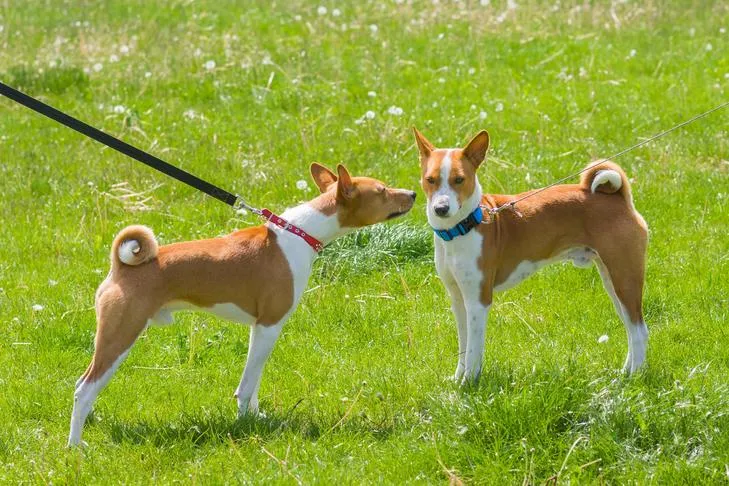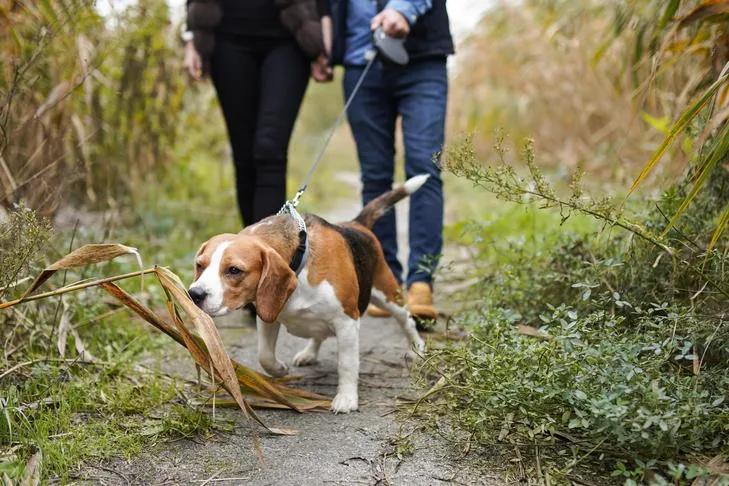Walking your dog should be an enjoyable experience for both of you, a chance to explore the world together. However, a common challenge many dog owners face is their furry friend pulling relentlessly on the leash. This behavior isn’t just annoying; it can be unsafe, leading to discomfort for you and potentially harmful situations for your dog. Nobody wants to be dragged down the street, and with a larger dog, forceful pulling can even result in injuries. Learning teaching your dog to not pull on leash is crucial for a harmonious relationship and safe outings.
While leash pulling is a widespread issue, it’s not an insurmountable one. There are straightforward techniques you can employ to teach your dog appropriate leash manners. Additionally, making small adjustments to your own behavior during walks can significantly impact your dog’s progress. By consistently applying these tips, you and your dog will soon be walking side-by-side, enjoying pleasant strolls instead of a tug-of-war.
Always Reward Good Leash Behavior
It’s easy to overlook good behavior, but never take your dog’s polite leash walking for granted. Dogs are more likely to repeat actions that result in a positive outcome. Whether the reward is a tasty treat, enthusiastic praise, or even the chance to stop and sniff something interesting, positive reinforcement is key. If you only focus on correcting what your dog does wrong and ignore their good behavior, they are more likely to resort to less desirable ways to get what they want.
Always be ready to reinforce your dog whenever they are walking nicely on the leash. Carry treats with you, or be prepared with pets and verbal praise. Don’t be shy with your rewards, especially in the beginning. Let your dog know you appreciate their calm and cooperative behavior. Start by rewarding frequently and generously. As your dog’s skills improve, you can gradually reduce the frequency of treats, substituting them with “life rewards” like the opportunity to explore a tree trunk or briefly greet a friendly dog.
Never Let Your Dog Walk When They Are Pulling
Your dog’s primary motivation for pulling is often simply to move forward and explore. Therefore, if you allow them to continue walking while they are pulling, you are inadvertently rewarding the very behavior you want to stop. Dogs will repeat behaviors that earn them rewards, so permitting forward movement while pulling will only reinforce and worsen the habit in the long run. To effectively address this, establish a firm rule: never walk when your dog is tugging on the leash. The moment you feel tension, stop, plant your feet, and wait.
 Two Basenjis meet in a grassy field, one on a leash, demonstrating calm interaction.
Two Basenjis meet in a grassy field, one on a leash, demonstrating calm interaction.
This pause should continue until your dog either returns to your side or the tension on the leash slackens. This teaches them that pulling immediately halts their desired activity—walking—and that a loose leash is the only way to proceed. Learning how to stop my dog from dragging me is all about consistency and teaching your dog that pulling is counterproductive to their goals.
Wait for a Loose Leash Before You Walk
If stopping is the first step when your dog pulls, the next crucial step is knowing when to resume the walk. The signal to start moving again is a slack leash, ideally hanging in a gentle J-shape, and your dog turning their attention back to you. This might require a significant amount of patience initially, as your dog learns the connection. However, they will eventually look back or walk back to investigate why you’ve stopped.
At that precise moment, offer praise and a treat positioned at your side, then calmly continue your walk. In the early stages of training, you might find yourself stopping and starting every few steps. This is a normal part of the process. Your dog will quickly begin to understand that pulling brings the walk to a halt, while maintaining a loose leash allows them to keep moving forward. This consistent consequence helps solidify polite walking habits.
Incorporate Life Rewards on Your Walk
Walks should be a rich and engaging experience for your dog, offering more than just a chance to relieve themselves. They should provide both physical exercise and crucial mental stimulation. When you’re actively training your dog not to pull, it can sometimes feel like these enriching elements are missing. A great way to boost your training while enhancing your dog’s walk is by incorporating “life rewards” for following the rules.
Life rewards are the everyday things your dog naturally enjoys, such as the chance to sniff a bush, investigate a patch of grass, or greet a friendly stranger. For example, if your dog walks politely for a stretch of 10 feet without pulling, you could release them to sniff for a few minutes as a reward. These bonus rewards are powerful motivators, truly convincing your dog that walking politely yields desirable outcomes. This method helps your dog realize that good behavior actually enables the fun parts of the walk. To learn more about advanced training, consider how to train a dog to walk without pulling even more effectively.
Walk at a Good Pace
Often, humans naturally walk at a pace that is far too leisurely for most dogs. Even small toy breeds can have a quick trot that surpasses a slow human stroll. This discrepancy in desired speed is often a contributing factor to why dogs pull – they simply want to get moving faster. To help your dog feel more invested and engaged in the walk, try to choose a pace that is comfortable and invigorating for both of you.
While you can certainly train your dog to match your speed, during the initial stages of no-pull training, a slightly quicker pace can actually make it easier for them to learn. A brisk walk keeps their focus and energy moving forward with you, rather than allowing them to feel the urge to surge ahead. This can create a more collaborative walking rhythm that benefits both partners on the leash.
Be Consistent With Your No-Pulling Rule
Consistency is paramount in dog training. It can be incredibly tempting to let your dog pull when you’re pressed for time—perhaps you’re running late for an appointment, or the weather is disagreeable, and you just want to get the potty break over with. However, you must be unwavering with your no-pulling rule, regardless of the circumstances. Every time you permit your dog to pull on the leash, you are essentially erasing previous training progress and sending mixed signals.
 A Beagle tugs on its leash to sniff the ground during an outdoor walk, illustrating common pulling behavior.
A Beagle tugs on its leash to sniff the ground during an outdoor walk, illustrating common pulling behavior.
Allowing pulling even once can set your training back significantly, requiring you to start over. Until you can consistently walk more than a few feet without pulling, consider letting your dog do their business in the yard or at the curb. Reserve your actual walks for dedicated training sessions when you have the time and patience to reinforce polite leash behavior. This unwavering approach is crucial for teaching how to stop a dog pulling on its lead.
Keep Training Sessions Short and Fun
Working with a determined leash puller can be frustrating. In the beginning, you might find that you make it no further than the end of your driveway before your dog starts pulling. Rather than pushing your dog (and yourself) to the point of exasperation or anger due to a lack of progress, it’s far more effective to keep your training sessions brief and upbeat.
Puppies, in particular, have very short attention spans, and asking for too much too soon will likely lead to negative results and a discouraged dog. Remember, the goal of these sessions isn’t necessarily to cover a certain distance; it’s to achieve a loose leash walk, even if that means only making it to the neighbor’s house and back. End on a positive note, even if it’s a small success, to keep your dog eager for the next training opportunity.
Be Interesting and Engaging on Walks
For dogs, the world is a vibrant tapestry of new sights, sounds, and especially smells. This means there are countless stimuli constantly competing for your dog’s attention and enticing them to pull you down the sidewalk. If you are preoccupied with your phone or otherwise ignoring your dog, there’s little reason for them to focus on you. However, if you make yourself interesting and worth observing, your dog will be much more likely to follow your lead.
Engage with your dog: talk to them, offer quick training breaks, stop for a brief game of “find it” with a treat, and vary your routine. This keeps your dog curious and always waiting to see what you will do next, strengthening your bond and improving their focus on you. A dog that finds you more interesting than every passing distraction is a dog that will naturally walk more politely.
Stay Calm
Walks can present a variety of emotionally charged situations, whether it’s the excitement of seeing a favorite neighbor or the apprehension of approaching a barking dog. Regardless of whether the situation is thrilling or frightening for your dog (and for you), maintaining control over your own emotions is vital. Dogs are incredibly adept at reading human emotions, and your mood can easily transmit down the leash to impact your dog.
 A Cavalier King Charles Spaniel is shown outdoors on a lead, calm and attentive.
A Cavalier King Charles Spaniel is shown outdoors on a lead, calm and attentive.
Your anxiety can intensify their fear, just as your excitement can ramp up their over-exuberance. To help your dog remain calm and focused, you need to stay calm yourself. Projecting a sense of serenity shows your dog there’s nothing to be overly excited or anxious about. The more relaxed your dog is, the more receptive they will be to your cues and the more likely they are to behave appropriately on the leash.
Engage Your Dog In Distracting Situations
When faced with distractions like other dogs, squirrels, or unfamiliar people, it’s easy for your dog to forget their leash manners and start pulling. Your dog might pull to investigate or to retreat, but in either case, polite walking can quickly be abandoned. The key is to help your dog cope with these distractions by redirecting their focus back to you.
Proactively engage them before they become overwhelmed. Calmly offer them treats or initiate a simple game. You can ask for a “sit” or a “hand target”—these are easy exercises that keep your dog engaged and thinking about you as the distraction passes. You can also teach your dog a “watch me” cue to establish eye contact, allowing you to control where their attention is directed. The goal is to grab your dog’s attention before they even notice the distraction, ideally preventing the pulling behavior from starting at all. You might even consider whether can you walk your dog without a leash is an option for certain areas once these skills are mastered.
By consistently implementing these strategies, you’ll transform frustrating leash struggles into enjoyable walks with a well-behaved companion. Patience, consistency, and positive reinforcement are your most powerful tools in teaching your dog to walk politely by your side.
